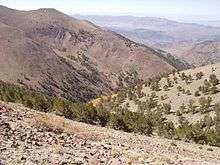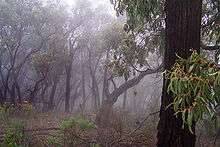Woodland
Woodland ![]() i/ˈwʊdlənd/ is a low-density forest forming open habitats with plenty of sunlight and limited shade. Woodlands may support an understory of shrubs and herbaceous plants including grasses. Woodland may form a transition to shrubland under drier conditions or during early stages of primary or secondary succession. Higher density areas of trees with a largely closed canopy that provides extensive and nearly continuous shade are referred to as forests.
i/ˈwʊdlənd/ is a low-density forest forming open habitats with plenty of sunlight and limited shade. Woodlands may support an understory of shrubs and herbaceous plants including grasses. Woodland may form a transition to shrubland under drier conditions or during early stages of primary or secondary succession. Higher density areas of trees with a largely closed canopy that provides extensive and nearly continuous shade are referred to as forests.
Conservationists have worked hard to preserve woodlands, because people are destroying animals habitats when building homes and other buildings. For example, the woodlands in Northwest Indiana have been preserved as part of the Indiana Dunes.[1][2][3]
Woodland is used in British woodland management to mean tree-covered areas which arose naturally and which are then managed, while forest is usually used in the British Isles to describe plantations, usually more extensive, or hunting Forests, which are a land use with a legal definition and may not be wooded at all.[4] The term "ancient woodland" is used in British nature conservation to refer to any wooded land that has existed since 1600, and often (though not always) for thousands of years, since the last Ice Age[4] (equivalent to the American term old-growth forest).
Woodlot is a closely related American term, which refers to a stand of trees generally used for firewood. While woodlots often technically have closed canopies, they are so small that light penetration from the edge makes them ecologically closer to woodland than forest.
Woodland ecoregions


Tropical and subtropical grasslands, savannas, and shrublands
- Afrotropic ecozone
- Angolan Miombo woodlands (Angola)
- Angolan Mopane woodlands (Angola, Namibia)
- Central Zambezian Miombo woodlands (Angola, Burundi, Democratic Republic of the Congo, Malawi, Tanzania, Zambia)
- Eastern Miombo woodlands (Mozambique, Tanzania)
- Kalahari Acacia-Baikiaea woodlands (Botswana, Namibia, South Africa, Zimbabwe)
- Zambezian and Mopane woodlands (Botswana, Malawi, Mozambique, Namibia, South Africa, Swaziland, Zambia, Zimbabwe)
- Zambezian Baikiaea woodlands (Angola, Botswana, Namibia, Zambia, Zimbabwe)
- Neotropic ecozone
- Cerrado woodlands and savannas (Bolivia, Brazil, Paraguay)
Temperate grasslands, savannas, and shrublands
- Afrotropic Ecozone
- Palearctic ecozone
- Gissaro-Alai open woodlands (Kyrgyzstan, Tajikistan, Uzbekistan)
Montane grasslands and shrublands

- Afrotropic ecozone
- Angolan Scarp savanna and woodlands (Angola)
- Drakensberg alti-montane grasslands and woodlands (Lesotho, South Africa)
- Drakensberg montane grasslands, woodlands and forests (Lesotho, South Africa, Swaziland)
- East African montane moorlands (Kenya, Sudan, Tanzania, Uganda)
- Ethiopian montane grasslands and woodlands (Ethiopia)
- Palearctic ecozone
- Kopet Dag woodlands and forest steppe (Iran, Turkmenistan)
Mediterranean forests, woodlands, and scrub

- Australasia ecozone
- Coolgardie woodlands (Australia)
- Mount Lofty woodlands (Australia)
- Murray-Darling woodlands and mallee (Australia)
- Naracoorte woodlands (Australia)
- Southwest Australia woodlands (Australia)
- Nearctic ecozone
- Palearctic ecozone
- Baccanico (berrywood) an area with a high density of all sorts of berry ("berry" in Italian "bacca") trees.
- Canary Islands dry woodlands and forests (Spain)
- Mediterranean acacia-argania dry woodlands and succulent thickets (Morocco, Canary Islands (Spain))
- Mediterranean dry woodlands and steppe (Algeria, Egypt, Libya, Morocco, Tunisia)
- Mediterranean woodlands and forests (Algeria, Morocco, Tunisia)
- Southeastern Iberian shrubs and woodlands (Spain)
Deserts and xeric shrublands
- Afrotropic ecozone
- East Saharan montane xeric woodlands (Chad, Sudan)
- Madagascar succulent woodlands (Madagascar)
- Somali montane xeric woodlands (Somalia)
- Southwestern Arabian montane woodlands (Saudi Arabia, Yemen)
- Palearctic ecozone
- Baluchistan xeric woodlands (Afghanistan, Pakistan)
- Central Afghan Mountains xeric woodlands (Afghanistan)
- Central Asian riparian woodlands (Kazakhstan)
- North Saharan steppe and woodlands (Algeria, Egypt, Libya, Morocco Tunisia, Western Sahara)
- Paropamisus xeric woodlands (Afghanistan)
- South Saharan steppe and woodlands (Algeria, Chad, Mali, Mauritania, Niger, Sudan)
- Tibesti-Jebel Uweinat montane xeric woodlands (Chad, Egypt, Libya, Sudan)
- West Saharan montane xeric woodlands (Algeria, Mali, Mauritania, Niger)
See also
- Agroforestry
- Ancient woodland
- Biomass
- Biomass (ecology)
- Bioproduct
- Biosphere
- Boreal forest
- Canopy (biology)
- Clearcutting
- Close to nature forestry
- Cloud forest
- Chase (land)
- Deforestation
- Dendrology
- Dendrometry
- Ecological succession
- Forest dynamics
- Forest management
- Forest migration
- Forest pathology
- Forestry Commission
- History of the forest in Central Europe
- Illegal logging
- Intact forest landscape
- Jungle (terrain)
- Kelp forest (A forest made mostly if not entirely of Kelp; an underwater forest)
- List of countries by forest area
- List of old-growth forests
- List of superlative trees
- List of tree genera
- List of trees and shrubs by taxonomic family
- Lists of trees of the world
- Natural environment
- Natural landscape
- Old-growth forest (ancient forest, virgin forest, primary forest)
- Orchard
- Permaforestry
- Plantation (forestry)
- Rainforest
- REDD-plus
- Silviculture
- Subalpine forest
- Taiga
- Temperate broadleaf and mixed forests
- Temperate coniferous forests
- Tree
- Tree allometry
- Tree farm
- Tropical rainforest
- Tropical and subtropical coniferous forests
- Tropical and subtropical moist broadleaf forests
- Wildcrafting
- Wilderness
- Woodland management
References
- ↑ Smith, S. & Mark, S. (2006). Alice Gray, Dorothy Buell, and Naomi Svihla: Preservationists of Ogden Dunes. The South Shore Journal, 1. http://www.southshorejournal.org/index.php/issues/volume-1-2006/78-journals/vol-1-2006/117-alice-gray-dorothy-buell-and-naomi-svihla-preservationists-of-ogden-dunes
- ↑ Smith, S. & Mark, S. (2009). The Historical Roots of the Nature Conservancy in the Northwest Indiana/Chicagoland Region: From Science to Preservation. The South Shore Journal, 3. http://www.southshorejournal.org/index.php/issues/volume-3-2009/83-journals/vol-3-2009/75-the-historical-roots-of-the-nature-conservancy-in-the-northwest-indianachicagoland-region-from-science-to-preservation
- ↑ Smith, S. & Mark, S. (2007). The cultural impact of a museum in a small community: The Hour Glass of Ogden Dunes. The South Shore Journal, 2. http://www.southshorejournal.org/index.php/issues/volume-2-2007/82-journals/vol-2-2007/104-the-cultural-impact-of-a-museum-in-a-small-community-the-hour-glass-in-ogden-dunes
- 1 2 Rackham, Oliver (2006). Woodlands (New Naturalist 100). London: HarperCollins. ISBN 9780007202447.
External links
![]() Media related to Woodlands at Wikimedia Commons
Media related to Woodlands at Wikimedia Commons